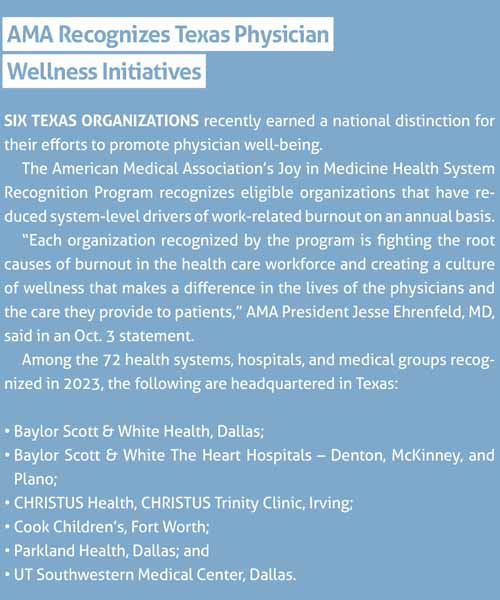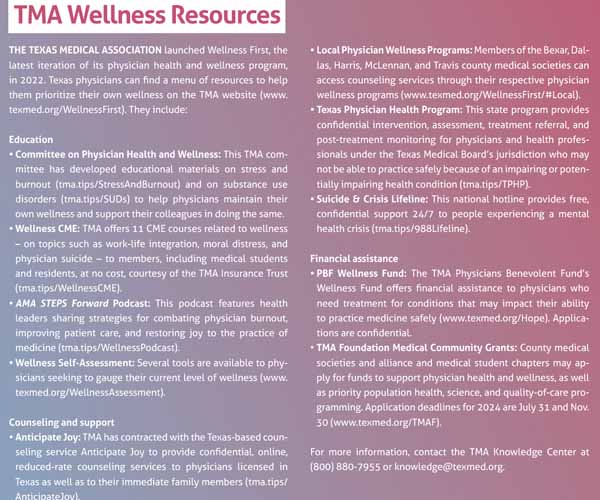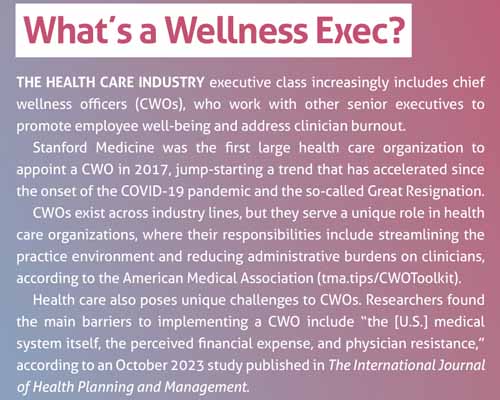
Glenn Ledbetter, MD, an internist in Waxahachie, leads the statewide physician wellness initiative at Baylor Scott & White Health.
Prior to COVID-19, he says the initiative – like many others across Texas and the U.S. – was “nibbling around the edges” of physician burnout, by surveying its physicians about the problem.
But the pandemic highlighted the dire straits in which physicians and health professionals had found themselves. Burnout quickly reached a fever pitch, fueled by long-standing workforce shortages, quickening clinician turnover, declining physician payment, and growing administrative burdens. An aging patient population, which will further strain the health care system in the years ahead, suggested the situation would only deteriorate.
“We had to have an aggressive approach to restore the workforce and repair the distress that they were feeling,” Dr. Ledbetter told Texas Medicine.
Today, the initiative is transformed. It now encompasses a peer-support program, a Women in Medical Leadership group, regular discussions and events, and more rigorous data measurement.
Through this work, Baylor Scott & White Health has identified risk factors for physician burnout, including being on call and so-called “pajama time,” when physicians work after hours to document patient visits, bill for services, and request prior authorization. The health system also has taken steps to mitigate these factors, such as by limiting physicians’ on-call hours and off-loading some of their electronic health record note-taking responsibilities to other members of the care team.
Dr. Ledbetter says the initiative has benefited from others’ expertise, including that of its own physician leaders; Baylor Scott & White The Heart Hospital in Plano, which has its own initiative; and the American Medical Association’s Joy in Medicine Health System Recognition Program, which provided a model for expansion. (See “AMA Recognizes Texas Physician Wellness Initiatives,” page 17.)

“We’re all in this together,” Dr. Ledbetter said. “We all know that we don’t have enough physicians. We can’t have them leave [practice] early or retire … because it’s too much for them.”
After years of sounding the alarm about physician burnout and demanding systemic changes, organized medicine – and the health care industry more broadly – is teeming with physician-led wellness initiatives on this same turbocharged trajectory. The Texas Medical Association, AMA, and others have expanded their own physician wellness programs, invested in related research, and built new infrastructure within their organizations to prevent physician burnout in current and future physicians.
Their commitment is bearing fruit: According to the latest studies, physician burnout rates appear to be on the wane, if not yet back at prepandemic levels. Meanwhile, health care organizations increasingly are collaborating to build on this momentum. (See “Taking the Temperature on Physician Burnout,” page 20.)
“The conversation has just gotten louder,” Dr. Ledbetter said.
Joseph Valenti, MD, a gynecologist in Denton and a member of the TMA Board of Trustees, adds that physician wellness initiatives complement ongoing legislative advocacy to eliminate certain drivers of burnout, such as a broken Medicare physician payment system and prior authorization hassles. (See “Putting Patient Care Before Paperwork,” page 26.)
“[Advocacy doesn’t] need to be done at the exclusion of other issues [like physician wellness] because the other issues affect everyone as well,” he said.
Because policy change takes time – often years of sustained grassroots advocacy – physician leaders at TMA and elsewhere have taken up the mantle of caring for their own.
At TMA, the treatment plan includes Wellness First, the latest iteration of the association’s physician health and wellness program, which provides confidential counseling services. (See “TMA Wellness Resources,” page 16.)

Beyond Texas, The Physicians Foundation continues to research physician wellness and fund related programs. The National Academy of Medicine recently celebrated the first anniversary of its National Plan for Health Workforce Well-Being, which raises workforce well-being to the priority level of population health, quality care, cost effectiveness, and health equity. And institutions are appointing a chief wellness officer (CWO), a new role that’s growing more common across the health care industry. (See “What’s a Wellness Exec?” page 19.)
Dr. Valenti, who also serves on The Physicians Foundation board, says these efforts amount to a pandemic-era paradigm shift that is changing medicine for the better.
“Being a physician is challenging, but the future of medicine shouldn’t be this challenging.”
Supporting the profession
TMA has long prioritized physician wellness, as evidenced by several recent developments years in the making.
Last January, the association launched a partnership with the Texas-based counseling service Anticipate Joy to provide reduced-rate counseling services to Texas physicians and their immediate family members.
“Making affordable counseling encouraged and accessible to physicians is really one of the best things we’re doing [as an association],” said Emma Dishner, MD, an infectious disease specialist in Dallas and a member of TMA’s Committee on Physician Health and Wellness. She benefited from counseling during her residency after her mother’s sudden death.
Anticipate Joy supplements other resources, including physician wellness programs offered at the county medical society (CMS) level.
For instance, the Travis CMS Physician Wellness Program’s Safe Harbor Counseling Program provides at least four free visits with a vetted, doctorate-level psychotherapist for any member and their life partner.
Brian Sayers, MD, a rheumatologist in Austin and chair of the Travis CMS Physician Wellness Program, celebrates two recent developments: Earlier this year, Travis CMS expanded the program to physicians insured by the Texas Medical Liability Trust, and, in October, it funded its 2,000th counseling session.
TMA also has incorporated physician well-being into conferences. TexMed 2023 featured a wellness-focused CME track and “wellness zone,” which provided space to talk with peers and massage services, courtesy of the association’s Committee on Physician Health and Wellness.
Jasmine Liu-Zarzuela, a fourth-year student at the UTMB John Sealy School of Medicine who represents the TMA Medical Student Section on the committee, hopes this feature becomes a mainstay of future conferences.
“That was really cool to see, something tangible that came out of the committee’s work,” she said.
At the same conference, the TMA House of Delegates voted to create a standing Committee on Behavioral Health, building on an existing subcommittee. Inaugural committee members are currently at work drafting a mission statement, which will include physician wellness. This is due, in part, to the state’s shortage of behavioral health professionals, which further strains physicians caring for patients with mental health care needs. (See “Mental Relief,” page 34.)
Celia Neavel, MD, an adolescent medicine physician in Austin and co-chair of the committee, hopes the committee continues to connect Texas physicians to evidence-based strategies and tools that ease the provision of behavioral health care – and the stresses that result when physicians are unable to do their job of caring for their patients.
“My own physicians talk about the moral injury of the health care system,” she said. “That is really difficult. But if I can be, for the patients that I do see, present for them and hear their story … then that can be a positive experience.”
As the director of the Center for Adolescent Health at People’s Community Clinic, Dr. Neavel practices in an integrated behavioral health care model that allows her to lean on other licensed behavioral health clinicians. The model “creates this whole ambience of support,” she said, and bolsters her own professional satisfaction.
She also relies on motivational interviewing and the Screening, Brief Intervention, and Referral to Treatment – or SBIRT – approach to treating substance use disorders, which have helped her establish boundaries with patients and families, a critical step to maintaining her own wellness.
Alongside organized medicine, health systems like Baylor Scott & White and academic institutions are doing their part to root out the systemic drivers of physician burnout and turnover.
Stanford Medicine, for example, became the first large health care organization in the U.S. to appoint a chief wellness officer in 2017. Over the past several years, medical schools have made similar appointments, albeit by different titles, as a part of recent accreditation requirements that emphasize wellness.

UTMB Health named Cara Geary, MD, to its inaugural CWO position in 2022 to oversee wellness for the system, including the medical school.
Dr. Geary’s interest in physician wellness is long-standing and has evolved over the course of her career. She developed a meditation practice during her neonatology fellowship, going on to offer meditation training to other physicians and then to create the Physician Healer Scholarly Concentration at UTMB.
“I truly care about helping [physicians] maintain their ability to care because without that we’re not effective and we won’t survive in these careers,” she said.
This work made Dr. Geary a shoo-in to lead UTMB’s faculty wellness program, which was on the cusp of upgrading from an unofficial task force to an official committee when the pandemic hit.
Initially, the funding for the program was shunted toward “keeping our bigger missions alive and functioning, very legitimately,” she said.
But the pandemic ultimately catalyzed the program’s development, much like at Baylor Scott & White Health. Soon, Dr. Geary set out to create a pilot, using the Stanford model as a template and eschewing a focus on personal resiliency.
“If you’re dealing with physicians, they’re a very resilient people right off the bat,” she said.
Instead, UTMB debuted two long-term courses in January 2023, one focused on improving efficiency in the practice environment and the other on promoting a positive workplace culture.
Since then, the pilot has grown to include “commensality groups,” made up of six to eight faculty members who meet for dinner each month to discuss the virtues and challenges of being a physician, and other components.
“Bringing people together for these courses alone has been beneficial for their wellness,” she said. “They realize as individuals that they’re not alone in their concerns and motivations.”
The camaraderie extends beyond UTMB.
As Dr. Geary prepares to expand the pilot campus-wide, she relies on the Healthcare Professional Well-being Academic Consortium, of which UTMB is a member. The consortium, headquartered at Stanford Medicine, evaluates health professional wellness programs and studies how to improve workforce well-being. Its member organizations also share what they’ve learned along the way.
“Knowing what other people are doing and the struggles that we all share is tremendously helpful,” she said.
Paving the way for a future generation unburdened by burnout, organized medicine also aims to inculcate wellness in medical students.
The Physicians Foundation’s steady research, including its 2023 Survey of America’s Current and Future Physicians, shows medical students are especially affected by burnout compared with residents and physicians. This research also has exposed some of the underlying reasons.
“Everyone who went to medical school knew [it] would be hard,” Dr. Valenti said. “But there’s also a lot of financial pressure on students, and our lack of ability to keep up residency positions [nationally … is] a big stressor for them.”
It’s this kind of research that is helping organized medicine make headway with a seemingly intractable problem.
As a board member at both The Physicians Foundation and TMA, Dr. Valenti said, “It’s nice for me to be able to … use that research to bring to bear what TMA’s focus is.”
Ms. Liu-Zarzuela, the UTMB student and an aspiring psychiatrist, also had a chance to effect change within the association.
“Seeing [medical school] colleagues and friends go through depressive symptoms, major depression, and even suicide attempts … it’s definitely very real,” she said.
The TMA Medical Student Section, to which she belongs, helped draft a resolution related to physician wellness that the House of Delegates adopted at TexMed 2023.
The new TMA policy that resulted condemns workplace bullying and encourages health care organizations to take actions to counter it. (See “Safety in Statute,” page 30.) The Physician Health and Wellness Committee also provided input on a second resolution, developed by the Council on Medical Education and adopted at the same event. The resolution amends existing TMA policy to further address burnout among medical trainees.
“Hopefully these resolutions create awareness and encourage institutions to keep moving forward on the issue [of physician wellness],” Ms. Liu-Zarzuela said.
She also is heartened by generational shifts. For instance, The Physicians Foundation survey found medical student respondents were more likely to have sought medical attention for a mental health problem than their resident and physician counterparts, which may be a result of the fact that schools provide accessible resources.
Such changes have far-reaching ripple effects, Dr. Valenti says.
“They’re not only our future doctors but also our future TMA members.”